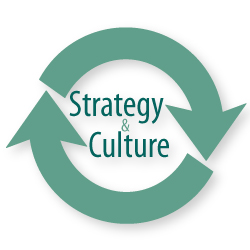Aligning Strategy & Culture for Long Term Employee Buy-In

Strategy versus culture. Culture versus strategy. The age old battle. Recruiters, human resource departments, and companies as a whole have struggled to understand and agree on which is more important to bringing overall organizational success. But what can you do to ensure that you are properly cultivating both?
A new article on the TLNT Magazine website offers up 5 steps for Aligning Culture for Strategic Buy In.
Why do Attempts to Change Culture Fail?
A report from Towers Watson last year revealed the critical interplay between culture and strategy and why it is imperative to align the two for overall success. Towers Watson defines culture as “the shared beliefs (either explicit or implicit) that exist within a company and drive behaviors.”
The first step towards truly aligning your company’s culture and strategy is to determine whether your culture aids or hinders your organization’s key goals.
Related: Maintain an Ongoing Recruiting Process
The report identifies two key elements that when missing, can ultimately lead to failure in an attempt to change a company’s culture:
1. A view of culture that goes beyond generic notions of “high performance” and focuses on those aspects of culture uniquely relevant to a company’s particular strategic goals.
2. A focus on the underlying systems, processes and behaviors to support long-term culture change.
Towers Watson then did an analysis, and defined 5 primary company strategies for success and the associated “cultural profiles” to achieve those strategies.
5 Steps to Connect Strategy and Culture
This analysis from Towers Watson is very valuable, but many organizations may not understand how to take these five profiles and apply them practically to drive strategic and cultural alignment among employees. After all, it’s key for employees to engage in this process as well as they’re the ones focused on achieving organizational goals. The article offers 5 steps towards helping employees draw this connection between culture and strategy.
1. Redefine the culture attributes into actionable core values. (Information Sharing, Teamwork, Customer Focus, Leadership, Decision Making, Taking Action)
2. Define behaviors associated with each of those core values. (Teamwork behaviors: Committed to common goals, active participation and leadership, open communication up and down the chain, willing sharing of resources)
3. Frequently and very specifically recognize any and all employees who demonstrate those behaviors by calling out clearly the core value demonstrated and explaining how those behaviors impacted you, the team, the customer or the company for the better. (Sam, you really lived our value of Teamwork when you went out of your way to locate the necessary research materials needed to move the Juno project forward. You didn’t have the information yourself, but you knew who did and how to get that information in the right hands. By doing so quickly and without prompting or direction, you helped us beat project deadlines, thrilling our client and making them a partner for years to come.)
4. Share that recognition across the organization so it can serve as training for others on what desirable “Teamwork” behaviors look like in the daily work, encouraging others to demonstrate similar actions.
5. Closely monitor, measure and report on areas where values are being more or less recognized to intervene where necessary with additional training or resources to ensure all employees both understand and are committed to achieving the company’s strategy – in their own work, every day.
Read the complete article on the TLNT website.